Abstract
Serum total cholesterol, triglycerides, high density lipoprotein cholesterol, low density lipoprotein cholesterol, apolipoprotein A-I and apolipoprotein B were evaluated as potential indicators of the risk of coronary artery disease in young (less than 46 years) normocholesterolaemic, non-diabetic men who had previously sustained a myocardial infarction (n = 50) and in healthy age and sex matched controls (n = 122) with a similar socioeconomic background. Significant differences were observed between patients and controls in the mean concentrations of serum total cholesterol, triglycerides, low density lipoprotein cholesterol, high density lipoprotein cholesterol and apolipoprotein B, as well as in the ratios of total cholesterol to high density lipoprotein cholesterol and apolipoprotein A-I to apolipoprotein B. No significant difference was demonstrated in the concentration of apolipoprotein A-I between the two groups. Stepwise discriminant analysis indicated that apolipoprotein B was the best discriminant between patients and controls. The percentage of exact classification was 74% in patients and 66% in controls. When the patients were compared to a subset of controls (n = 50) matched for age and total cholesterol, significant differences were demonstrated only in the mean concentrations of apolipoprotein B. Discriminant analysis confirmed that the best single discriminating variable was apolipoprotein B. The results therefore indicate that in young normocholesterolaemic, non-diabetic Indian men with myocardial infarction, apolipoprotein B is superior to other lipid parameters studied, as a marker for coronary artery disease.
Full text
PDF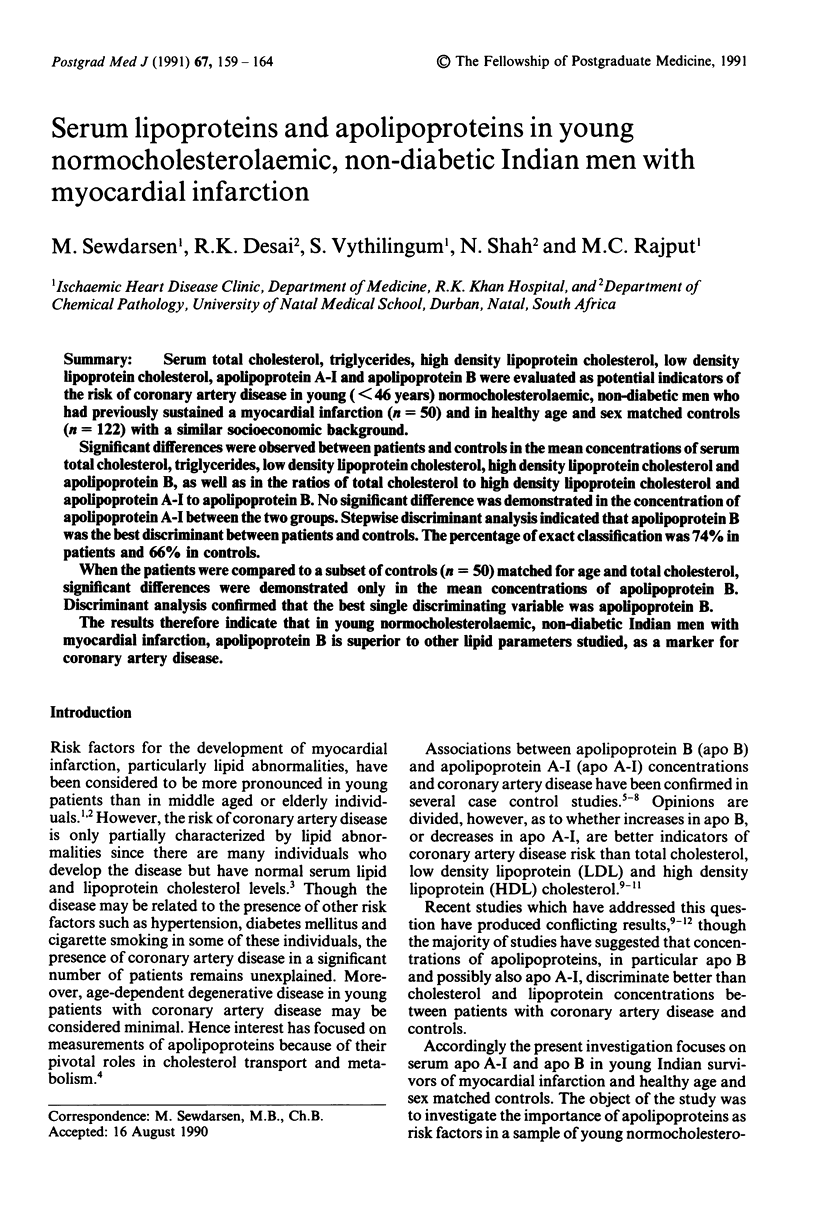
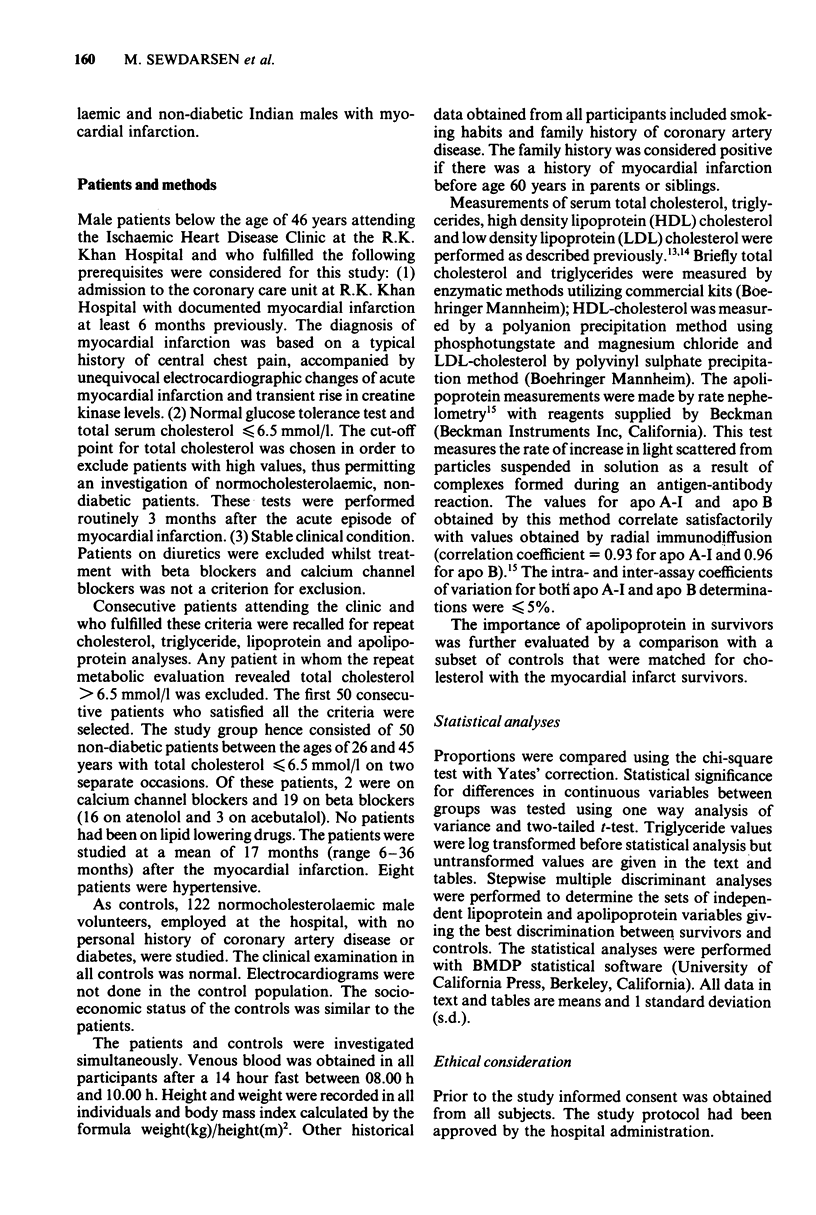
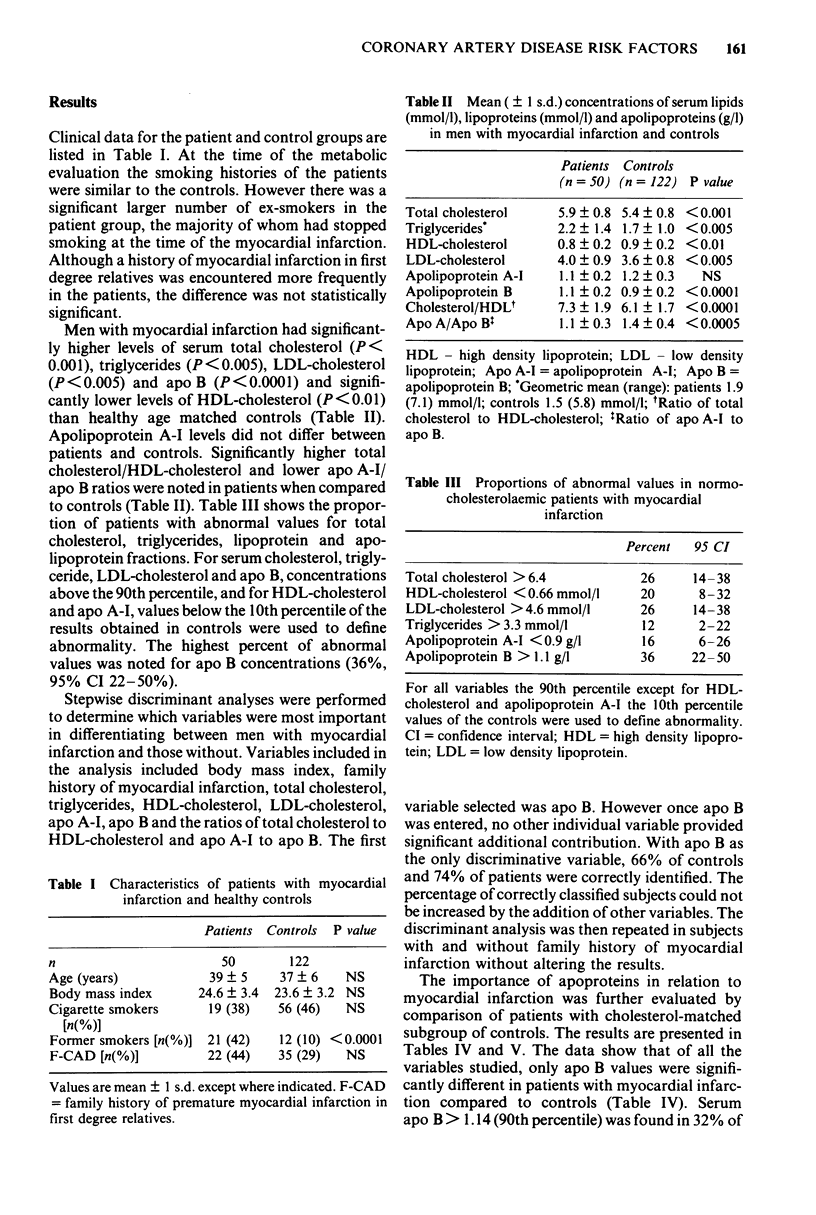
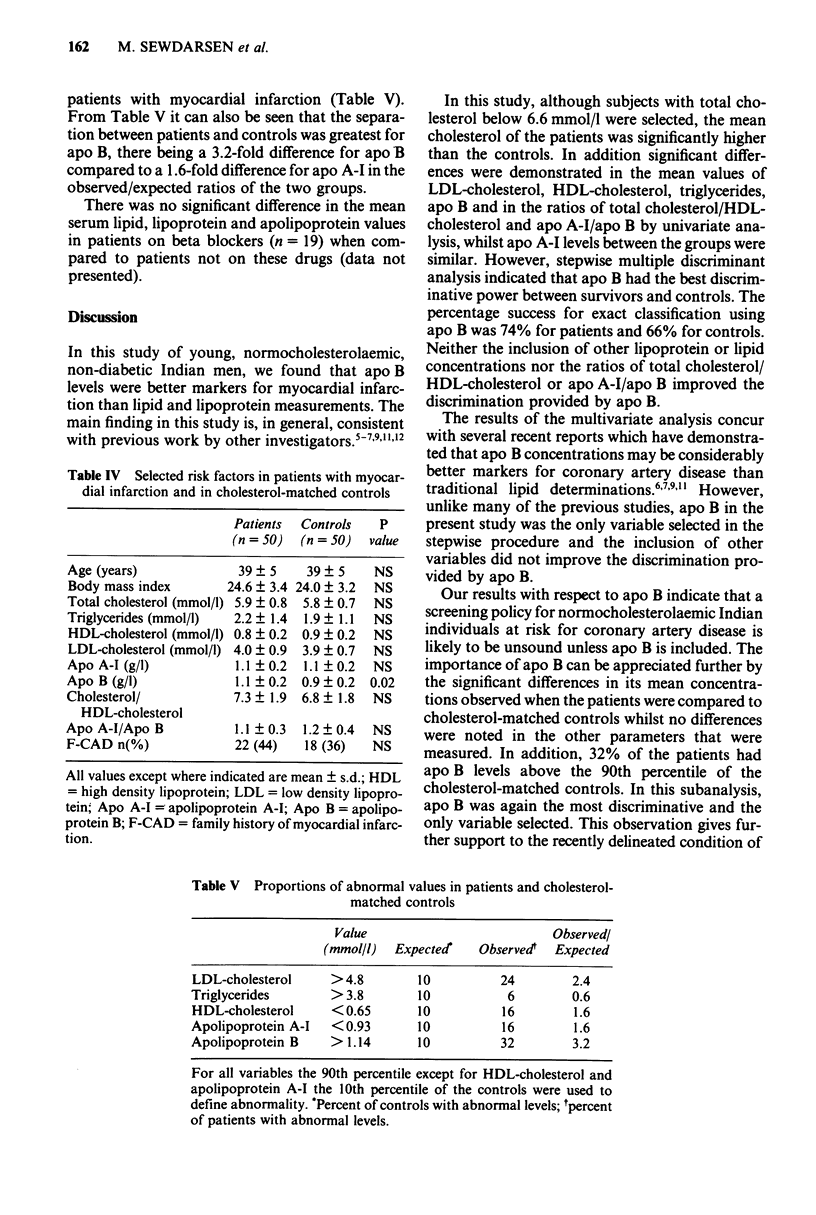
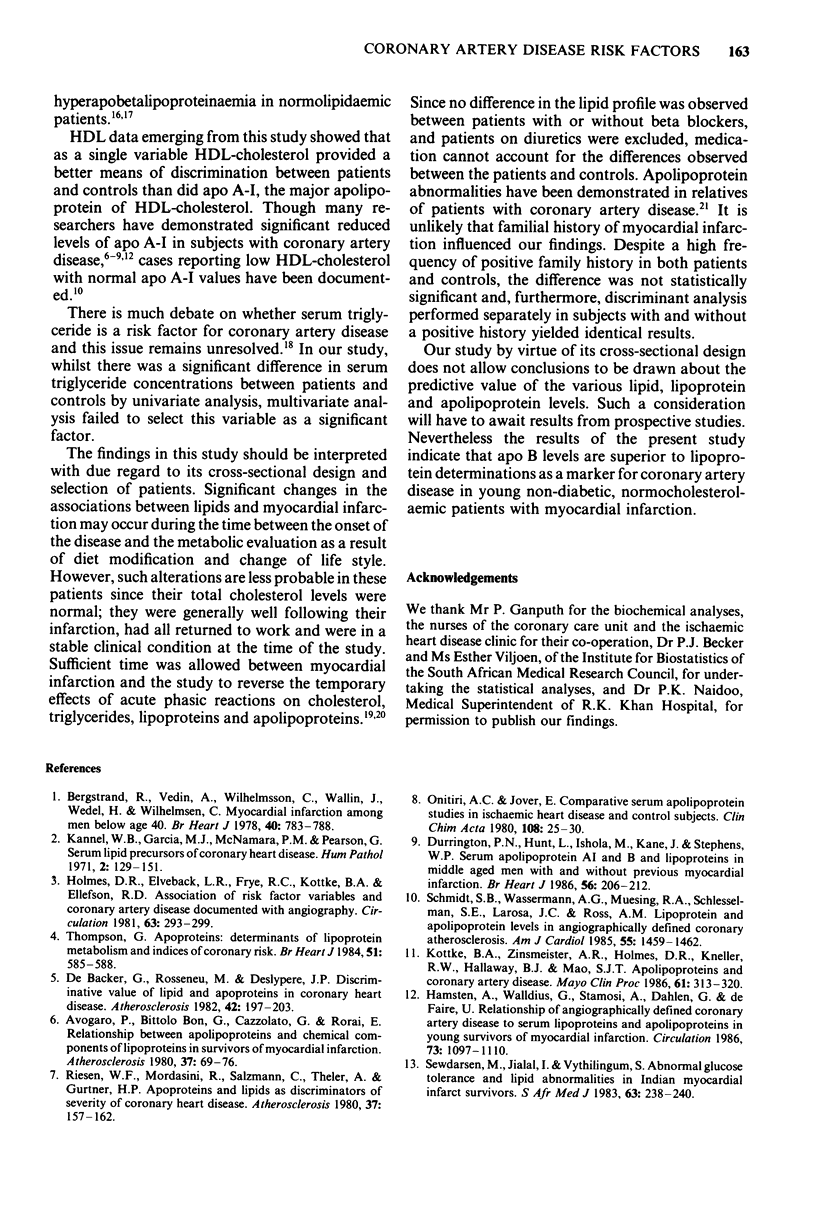
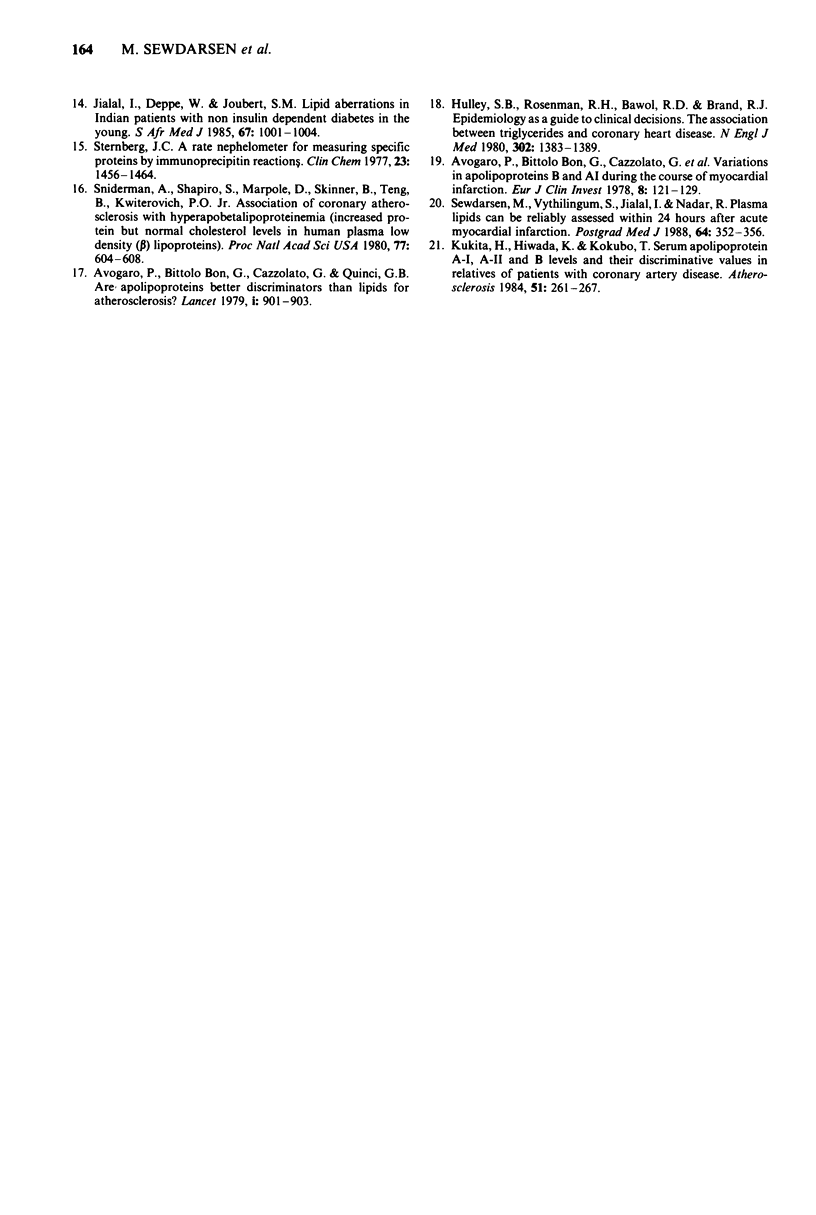
Selected References
These references are in PubMed. This may not be the complete list of references from this article.
- Avogaro P., Bon G. B., Cazzolato G., Quinci G. B. Are apolipoproteins better discriminators than lipids for atherosclerosis? Lancet. 1979 Apr 28;1(8122):901–903. doi: 10.1016/s0140-6736(79)91375-8. [DOI] [PubMed] [Google Scholar]
- Avogaro P., Bon G. B., Cazzolato G., Quinci G. B., Sanson A., Sparla M., Zagatti G. C., Caturelli G. Variations in apolipoproteins B and A1 during the course of myocardial infarction. Eur J Clin Invest. 1978 Jun;8(3):121–129. doi: 10.1111/j.1365-2362.1978.tb00824.x. [DOI] [PubMed] [Google Scholar]
- Avogaro P., Bon G. B., Cazzolato G., Rorai E. Relationship between apolipoproteins and chemical components of lipoproteins in survivors of myocardial infarction. Atherosclerosis. 1980 Sep;37(1):69–76. doi: 10.1016/0021-9150(80)90094-5. [DOI] [PubMed] [Google Scholar]
- Bergstrand R., Vedin A., Wilhelmsson C., Wallin J., Wedel H., Wilhelmsen L. Myocardial infarction among men below age 40. Br Heart J. 1978 Jul;40(7):783–788. doi: 10.1136/hrt.40.7.783. [DOI] [PMC free article] [PubMed] [Google Scholar]
- De Backer G., Rosseneu M., Deslypere J. P. Discriminative value of lipids and apoproteins in coronary heart disease. Atherosclerosis. 1982 Apr;42(2-3):197–203. doi: 10.1016/0021-9150(82)90150-2. [DOI] [PubMed] [Google Scholar]
- Durrington P. N., Hunt L., Ishola M., Kane J., Stephens W. P. Serum apolipoproteins AI and B and lipoproteins in middle aged men with and without previous myocardial infarction. Br Heart J. 1986 Sep;56(3):206–212. doi: 10.1136/hrt.56.3.206. [DOI] [PMC free article] [PubMed] [Google Scholar]
- Hamsten A., Walldius G., Szamosi A., Dahlen G., de Faire U. Relationship of angiographically defined coronary artery disease to serum lipoproteins and apolipoproteins in young survivors of myocardial infarction. Circulation. 1986 Jun;73(6):1097–1110. doi: 10.1161/01.cir.73.6.1097. [DOI] [PubMed] [Google Scholar]
- Holmes D. R., Jr, Elveback L. R., Frye R. L., Kottke B. A., Ellefson R. D. Association of risk factor variables and coronary artery disease documented with angiography. Circulation. 1981 Feb;63(2):293–299. doi: 10.1161/01.cir.63.2.293. [DOI] [PubMed] [Google Scholar]
- Hulley S. B., Rosenman R. H., Bawol R. D., Brand R. J. Epidemiology as a guide to clinical decisions. The association between triglyceride and coronary heart disease. N Engl J Med. 1980 Jun 19;302(25):1383–1389. doi: 10.1056/NEJM198006193022503. [DOI] [PubMed] [Google Scholar]
- Jialal I., Deppe W., Joubert S. M. Lipid and lipoprotein aberrations in Indian patients with non-insulin-dependent diabetes in the young. S Afr Med J. 1985 Jun 22;67(25):1001–1004. [PubMed] [Google Scholar]
- Kannel W. B., Garcia M. J., McNamara P. M., Pearson G. Serum lipid precursors of coronary heart disease. Hum Pathol. 1971 Mar;2(1):129–151. doi: 10.1016/s0046-8177(71)80023-0. [DOI] [PubMed] [Google Scholar]
- Kottke B. A., Zinsmeister A. R., Holmes D. R., Jr, Kneller R. W., Hallaway B. J., Mao S. J. Apolipoproteins and coronary artery disease. Mayo Clin Proc. 1986 May;61(5):313–320. doi: 10.1016/s0025-6196(12)61947-8. [DOI] [PubMed] [Google Scholar]
- Kukita H., Hiwada K., Kokubu T. Serum apolipoprotein A-I, A-II and B levels and their discriminative values in relatives of patients with coronary artery disease. Atherosclerosis. 1984 May-Jun;51(2-3):261–267. doi: 10.1016/0021-9150(84)90173-4. [DOI] [PubMed] [Google Scholar]
- Onitiri A. C., Jover E. Comparative serum apolipoprotein studies in ischaemic heart disease and control subjects. Clin Chim Acta. 1980 Nov 20;108(1):25–30. doi: 10.1016/0009-8981(80)90288-0. [DOI] [PubMed] [Google Scholar]
- Riesen W. F., Mordasini R., Salzmann C., Theler A., Gurtner H. P. Apoproteins and lipids as discriminators of severity of coronary heart disease. Atherosclerosis. 1980 Sep;37(1):157–162. doi: 10.1016/0021-9150(80)90104-5. [DOI] [PubMed] [Google Scholar]
- Schmidt S. B., Wasserman A. G., Muesing R. A., Schlesselman S. E., Larosa J. C., Ross A. M. Lipoprotein and apolipoprotein levels in angiographically defined coronary atherosclerosis. Am J Cardiol. 1985 Jun 1;55(13 Pt 1):1459–1462. doi: 10.1016/0002-9149(85)90953-1. [DOI] [PubMed] [Google Scholar]
- Sewdarsen M., Jialal I., Vythilingum S. Abnormal glucose tolerance and lipid abnormalities in Indian myocardial infarct survivors. S Afr Med J. 1983 Feb 12;63(7):238–240. [PubMed] [Google Scholar]
- Sewdarsen M., Vythilingum S., Jialal I., Nadar R. Plasma lipids can be reliably assessed within 24 hours after acute myocardial infarction. Postgrad Med J. 1988 May;64(751):352–356. doi: 10.1136/pgmj.64.751.352. [DOI] [PMC free article] [PubMed] [Google Scholar]
- Sniderman A., Shapiro S., Marpole D., Skinner B., Teng B., Kwiterovich P. O., Jr Association of coronary atherosclerosis with hyperapobetalipoproteinemia [increased protein but normal cholesterol levels in human plasma low density (beta) lipoproteins]. Proc Natl Acad Sci U S A. 1980 Jan;77(1):604–608. doi: 10.1073/pnas.77.1.604. [DOI] [PMC free article] [PubMed] [Google Scholar]
- Sternberg J. C. A rate nephelometer for measuring specific proteins by immunoprecipitin reactions. Clin Chem. 1977 Aug;23(8):1456–1464. [PubMed] [Google Scholar]
- Thompson G. Apoproteins: determinants of lipoprotein metabolism and indices of coronary risk. Br Heart J. 1984 Jun;51(6):585–588. doi: 10.1136/hrt.51.6.585. [DOI] [PMC free article] [PubMed] [Google Scholar]


